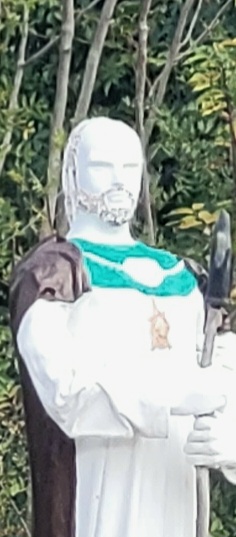Me after the hours long orientation....
We opted to stay in the harbour for the night as we were all a bit exhausted and the wind was gusting. Other than the Locaboat base, the only place open was a very cute open air restaurant, La Guinguette, just a short walk from the harbour. A couple of months ago when I was planning this trip, I had read that it was imperative to make reservations at any of the restaurants along the canal so I had gone through the painful process of trying to make one at La Guinguette. I gave up after a while but suspected that maybe I had actually made a reservation. When we finally got to the restaurant it was much later than I had planned so I figured I was out of luck but the server just said:"do you have a reservation??" And we said yes and the name and he muttered something and pointed to an empty table for three like he'd been waiting hours for us, which he had. So it all somehow worked out. The food was delicious. 
The next morning after breakfast we left the harbour and navigated our first lock, which Kent described accurately as a melee. The instructions during the orientation seemed simple enough but in practice, we all three of us completely forgot what to do and several other people had to come to our rescue. Ropes were flying, swear words too, and the lock keeper was yelling. We somehow made it through and out the other side, several feet lower and a bit worse for wear. After that it was smooth sailing for the rest of the day as there were no more locks on that section of the canal. It was lovely and peaceful to glide through fields of grapevines, stopping at little deserted villages.
As the sun set, we moored for the night just outside the small village of Roubia, made ourselves dinner and then crashed. The bed is more of a coffin than anything but that's ok when you sleep the sleep of the dead. The next day we had what seemed like several hundred locks ahead of us. For those of you not familiar, the locks raise or lower your boat along the canal (depending on which direction you go) by locking you into a compartment in the canal, then either filling it to raise you up to the next level, or draining it to lower you down. As you can imagine, there's a lot going on and it's a bit chaotic. Some of the locks are giant too.
This lock was a triple so we had to do this three times in a row. Fortunately we were traveling in a pack with the other two boats, and there weren't any boats going the other way, so the lock keeper didn't need to wait. They don't like to just do one boat at a time, it seems. The lock keeper, or éclusier, lives on site, usually in a super cute little house, and sometimes even has a little c or things for sale, like fresh eggs or local honey. You'll have to take my word for it as I'm often too busy holding ropes to take photos. Although I did see this guy, Garcon, standing in judgement over our locking skills:
Ok buddy. This entire region is given over to wine production and often the little towns are dominated by a winemaking cooperative. We stopped at one winery built in the 1860s still in use today. I was not prepared for how bad the smell was- something between a large pile of manure and a compost bin that has been out in the sun for too long. There was a museum of ancient wine making equipment there which was interesting, if you like that sort of thing, and some tasting at the end.
They were also selling all sorts of local produce including giant almonds that were twice the size of the ones we get at home, jams, pasta, olives and of course wine, and also this odd product:
I'm just not sure if we want body lotion made from donkey milk. Do we?
The funny thing about canal cruising is that you can only ever go a maximum of 8km/hr, and most times it's an average of about 5km/hr. Cruising after dark is not allowed. So in a day, you might get 14kms if you "hammer it" as Kent says. In the whole week, I think we might go 80kms total. I could get used to this slower way of life.
| 


















No comments:
Post a Comment